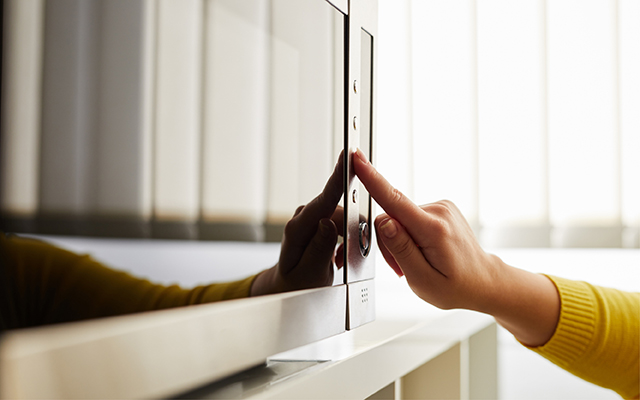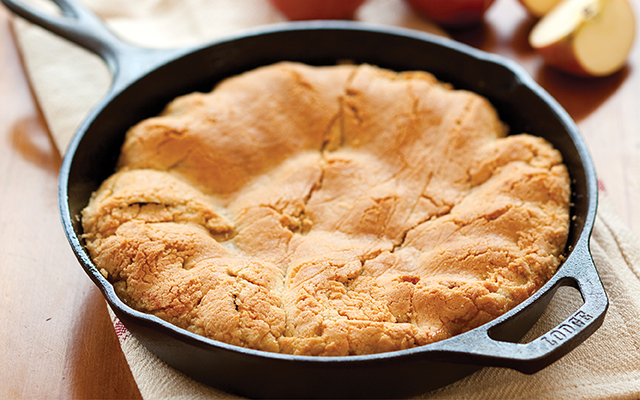Today’s kitchens are increasingly filled with conveniences that help get food on the table fast. Bagged salad greens. Rotisserie chickens. Single-serving instant oatmeal. Grated cheese. And when it comes to appliances, nothing beats the ubiquitous microwave for quick and easy cooking.
Most of us use our microwaves without giving it another thought: Pop in a frozen dinner or last night’s leftovers, and lickety-split it’s a hot meal. Despite worrisome terminology such as “radiation,” microwave ovens have worked their way into most kitchens and practically every break room in this country. They’re a staple of our lives.
But does anyone really know what’s going on inside the oven once you shut the door? How healthy or unhealthy is microwaving your food? And if we can’t live without our microwave ovens, what’s the best way to live with them?
Why Is Microwaving Called Nuking?
Let’s start with some history:
Around the end of World War II, an engineer discovered that the radar waves used to detect planes could also heat food. The first beastly microwave oven, called the Radarange, debuted in the late 1940s. A more user-friendly consumer countertop model hit store shelves two decades later. Soon afterward, the microwave became a miracle, must-have household appliance.
Microwaves work by using a magnetron that converts electric power into waves of oscillating electromagnetic energy, often referred to as microwaves, that are similar to radio waves.
People often say they are going to “nuke” their food, which is based on the common belief that microwaves reheat food by releasing radioactive energy. This is not, however, the case. Microwaves work by using a magnetron that converts electric power into waves of oscillating electromagnetic energy, often referred to as microwaves, that are similar to radio waves, explains Juming Tang, PhD, professor of food engineering at Washington State University in Pullman, Wash. “These waves permeate food, causing the agitation of water molecules and charged salt ions, which produces friction and a quick rise in temperature to warm the food rapidly,” he says.
Tang goes on to say that this is why the cooking times with microwave ovens are shorter than with conventional ovens: The latter oven sends heat through food relatively slowly, moving radiant heat inward from the outside.
“In a microwave oven,” says Tang, “the air in the appliance is at room temperature, so the temperature of the food surface is cooler to the touch than food placed in a conventional oven, where the items are heated by hot air or by radiative heat.” For this reason, to the angst and disappointment of many a home cook, food cooked in a microwave doesn’t generally become brown and crispy. The bigger concern about microwaves, though, is that while they are heating your food, they are also zapping valuable nutrients.
How Using a Microwave Kills Nutrients
According to microwave skeptics, the intermolecular friction created by the appliance reduces the bioavailability of essential vitamins and minerals, such as B vitamins and vitamin C. And it can even change the chemical composition of foods, including animal proteins and dairy.
“When food, including baby formula, is microwaved, it has been demonstrated that certain amino acids, which are the building blocks of protein, are converted from their natural, active forms into biologically inactive forms,” says Lita Lee, PhD, a chemist and enzyme therapist in Portland, Ore. Beyond the vitamins and minerals, she explains, foods contain a plethora of delicate and complex compounds, including antioxidants and enzymes, which could be negatively affected by microwaving.
Foods contain a plethora of delicate and complex compounds, including antioxidants and enzymes, which could be negatively affected by microwaving.
Skeptics like Lee are buttressed by a number of studies suggesting that the nutritional impacts of microwaving food are not entirely rosy. Japanese researchers determined that microwaving may convert vitamin B12 (a vitamin vital to proper neurological functioning, among many other things) in meat, pork and milk into its inactive form, rendering it somewhat useless.
Studies also show that heart-healthy phenolic compounds found in extra-virgin and virgin olive oils can lose some of their antioxidant capacities when exposed to microwaving, and that microwaving garlic can destroy its most powerful medicinal compound, allicin.
Comparative Cooking
A batch of other studies show, however, that the news surrounding microwaving and nutrient retention may not be so unappetizing after all, at least when compared with some other cooking methods — particularly boiling.
United Kingdom researchers reported in the journal Food and Chemical Toxicology that cooking a range of cruciferous vegetables like broccoli by steaming, stir-frying and microwaving did not produce a significant loss of glucosinolates, which are powerful disease-thwarting antioxidants. But when researchers boiled these same kinds of vegetables, they reported major glucosinolate losses through leaching into cooking water.
A 2009 Journal of Food Science study tested the antioxidant capacity of 20 vegetables, including Swiss chard and zucchini, when exposed to different cooking methods. Researchers found that microwaving drained antioxidant power less than pressure cooking and boiling.
“It’s clear that water is not a cook’s best friend when it comes to nutrient retention, whether in the microwave or on the stovetop,” says Barry Swanson, PhD, a food science professor at Washington State University. This could be why a much-publicized 2003 European study found that microwaving decimated broccoli’s flavonoid antioxidant levels. “The study authors added way too much water and cooked the vegetable for longer than what would occur in a normal household situation,” notes Swanson.
Compared with more destructive methods like boiling, the relatively mild temperatures and short cooking times associated with microwaving can do a good job at retaining nutrients in produce — as long as you use little, if any, water and don’t cook the life out of them.
“Microwaving for seconds or longer will destroy nutrients — by changing them to biologically inactive forms — and create toxins and carcinogens. Stovetop cooking cannot compare to the damage of microwaving.”
He says that compared with more destructive methods like boiling, the relatively mild temperatures and short cooking times associated with microwaving can do a good job at retaining nutrients in produce — as long as you use little, if any, water and don’t cook the life out of them. “High amounts of water provide a sea into which nutrients can get washed away,” Swanson says.
“There are many factors and conditions such as time and amount of added liquid that affect the nutritional value of food when cooked in the microwave,” says Samer Koutoubi, MD, PhD, a professor in the Department of Nutrition and Exercise Science at Bastyr University in Kenmore, Wash. “Many of the losses of nutrients that have been reported, including vitamin C, were mainly due to excess cooking water and spending too much time at the highest heat setting.”
Lee disagrees that excess water or cooking time is mainly to blame for nutrient loss. “Microwaving for seconds or longer will destroy nutrients — by changing them to biologically inactive forms — and create toxins and carcinogens. Stovetop cooking cannot compare to the damage of microwaving.”
Given the conflicting evidence, it’s clear that a consensus on the nutritional impacts of microwaving is probably anything but imminent. So for now, it’s up to individual cooks and eaters to decide whether they want to ditch their microwave or embrace it with cautious enthusiasm. If you decide on the latter, see “Microwave How-To” below, for tips. And if you decide on the former, think not just of the antioxidants you might save, but of the valuable counter space you stand to reclaim.
Pass on Plastic
A number of plastic items that often end up in the microwave, such as margarine and yogurt tubs, takeout packaging, and storage containers, are not designed to withstand the heat of microwaving, says Heather Patisaul, PhD, assistant professor in the Department of Biology at North Carolina State University. They may leak a range of chemicals into your cuisine, including carcinogens and hormone imitators, such as bisphenol A (BPA).
Says Patisaul:
“BPA appears to interfere with estrogen, an activity that is particularly disruptive during early development when hormones play an important role in organizing the brain and other organs. This is why it has been linked to neurological and development damage in offspring.”
A University of North Carolina study discovered mothers who showed higher levels of BPA at 16 weeks of gestation were more likely to have daughters who exhibited behaviors such as aggression and hyperactivity. A 2010 study further reported that U.S. adults with high urinary concentrations of BPA are more likely to develop heart disease and diabetes.
BPA isn’t, however, the only chemical to worry about. “Plastics contain numerous endocrine disrupting compounds, such as phthalates, and it’s very likely that we have not yet identified all of them,” says Patisaul. “It remains to be seen what they are, how much ends up in our bodies with microwaving, or if they are harmful to our health.” She points to a study, published in Environmental Health Perspectives earlier this year, that found that the vast majority of plastics, including baby bottles, leach hormone-mimicking chemicals during microwaving. In some cases, products labeled “BPA-free” released chemicals having more estrogenic activity than did BPA-containing products.
For these reasons, Patisaul believes it’s never a good idea to let plastic touch your food in the microwave. “There is really no such thing as completely safe microwaveable plastic,” she says.
“Microwaving food in microwave-safe ceramic or glass is the way to go if you want to avoid chemical exposure,” says Patisaul. “Glass and ceramic also last a long time, while plastic breaks down faster, is made from petroleum, and more often than not ends up in landfills and maybe even the ocean.” To be on the safe side, dump vegetables contained in steam-in-the-bag packages into glass or ceramic containers before microwaving.
Microwave How-To
If you choose to microwave your food, consider the following tips to help you maximize safety and reduce nutrient loss.
1. Use only glass and ceramic containers. A raft of data suggests that microwaving edibles in plastic can pollute our food with a hodgepodge of sketchy chemicals. For more information, see the “Pass on Plastic” sidebar.
2. Go easy on water and minimize time. When microwaving fruits or vegetables, use little or no water, says nutrition professor Samer Koutoubi, MD, PhD. Also, use as little time as possible for cooking. “These steps will minimize the nutrient loss,” he says. “There’s no reason to add water to vegetables or anything else that already contains a lot of moisture naturally,” adds food science professor Barry Swanson, PhD.
3. Put a lid on it. To retain surface moisture, cover food with a microwave-safe lid or wrap, leaving it slightly ajar to let steam escape, says Cheryl Luptowski, home safety expert at NSF International, an independent public-health and -safety organization based in Ann Arbor, Mich. “The moist heat will help destroy harmful bacteria and ensure uniform cooking.”
4. Out with the old. Leaks from an old and abused microwave oven are possible if the oven door is damaged or doesn’t seal properly. Regularly check your microwave for such signs and replace if needed. Make sure you clean off any food where the door meets the actual microwave, since, over time, crusty food residue can cause leakage.
The Healthiest Ways to Cook
If you want to live without a microwave, there is no reason you need to subsist on raw cauliflower or kale. Joy Feldman, NC, an integrative holistic-health nutritional consultant and health coach, provides her ranking of the healthiest and most flavorful cooking methods.
1. Steaming. Not only does steaming preserve flavor, aroma, vitamins and antioxidants, it also decreases the volume of vegetables so you can eat more. USDA researchers discovered that lightly steaming greens such as collards and broccoli increases their ability to bind to bile acids more than if consumed raw. With lower levels of circulating bile acids in the blood, the body uses cholesterol to make more bile, which in turn lowers cholesterol numbers and may confer heart-health benefits. Multistack electric steamers let you cook several items at once and are more energy efficient than stovetop steaming.
2. Stir-frying. The intense heat from the stovetop minimizes nutrient loss and helps maintain vegetable texture and color. High-quality woks are great for rapid, even heating at high temperatures, but you can also use a large, heavy, flat-bottom frying pan for stir-frying just about anything.
3. Sautéing. Sautéing involves cooking food in a moderate amount of fat (oil, butter, etc.) in a pan over direct heat. Cooking times tend to be longer than stir-frying, potentially resulting in slightly bigger nutrient losses.
4. Slow Cooker. Although heating for an extended period of time, even at low temperatures, will result in some nutrient loss, most of those nutrients can be salvaged if you wind up eating the sauce or cooking liquid in which the food was cooked.
5. Pressure cooking. Exposure to intense heat and surrounding liquids will cause some nutrient degradation, but the rapid cooking time will help offset this. Again, if you eat any surrounding sauces, you’ll recoup some of the nutrients.
Feldman deems baking, boiling, grilling, roasting and toasting as cooking methods to use less often, since they do a comparatively poor job at preserving nutrients and, in the case of grilling, can produce unhealthy compounds. Deep-frying is, in her view, the least desirable preparation method. “In addition to exposing you to inflammatory oxidized fats, frying foods produces cancer-causing chemicals,” says Feldman.
On the other hand, there’s an appropriate time and place for all cooking methods, so when in doubt, let your culinary sensibilities (as well as your nutritional conscience) be your guide.
This article originally appeared as “Inside the Microwave” in the January/February 2012 issue of Experience Life.




This Post Has 0 Comments